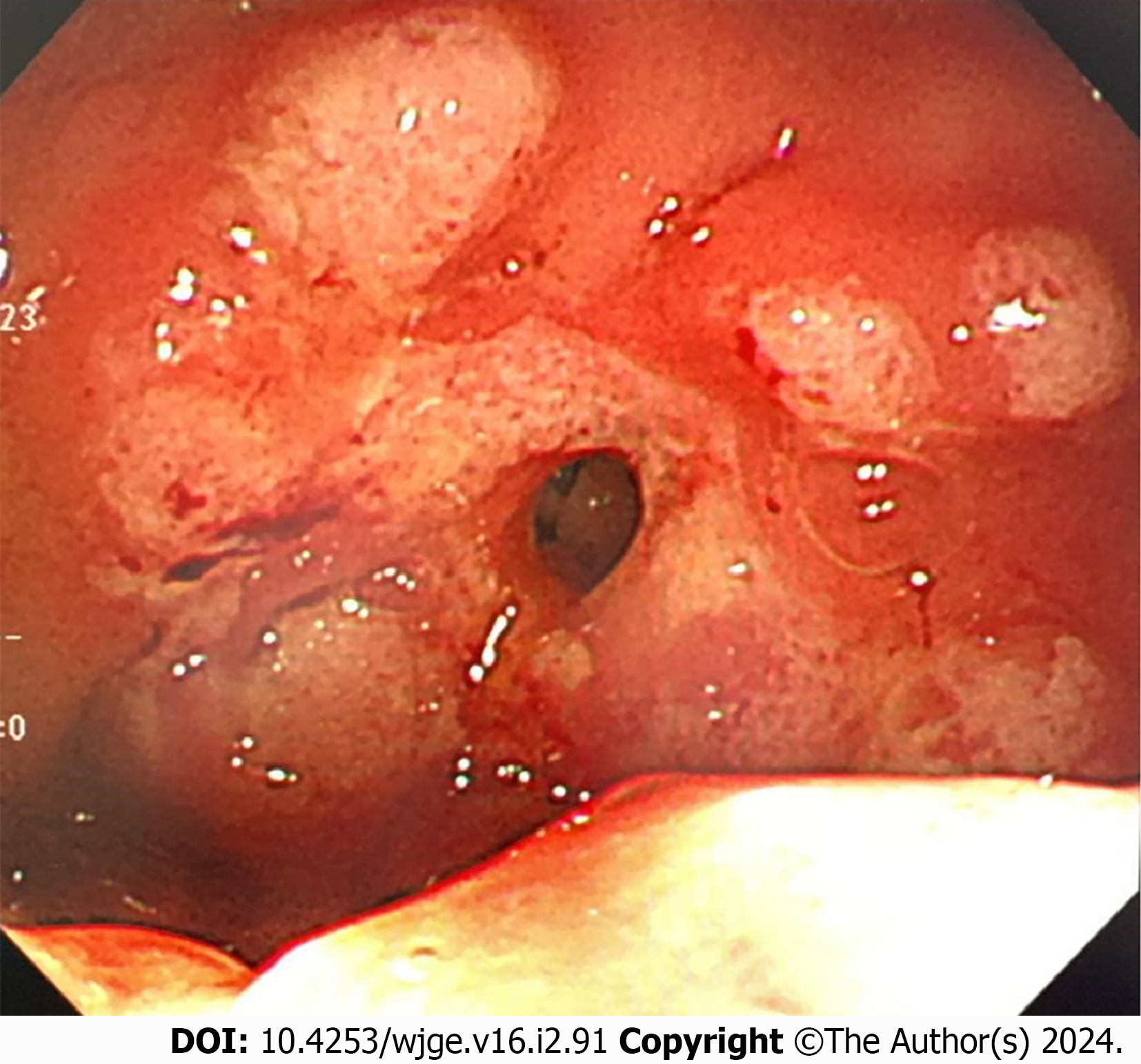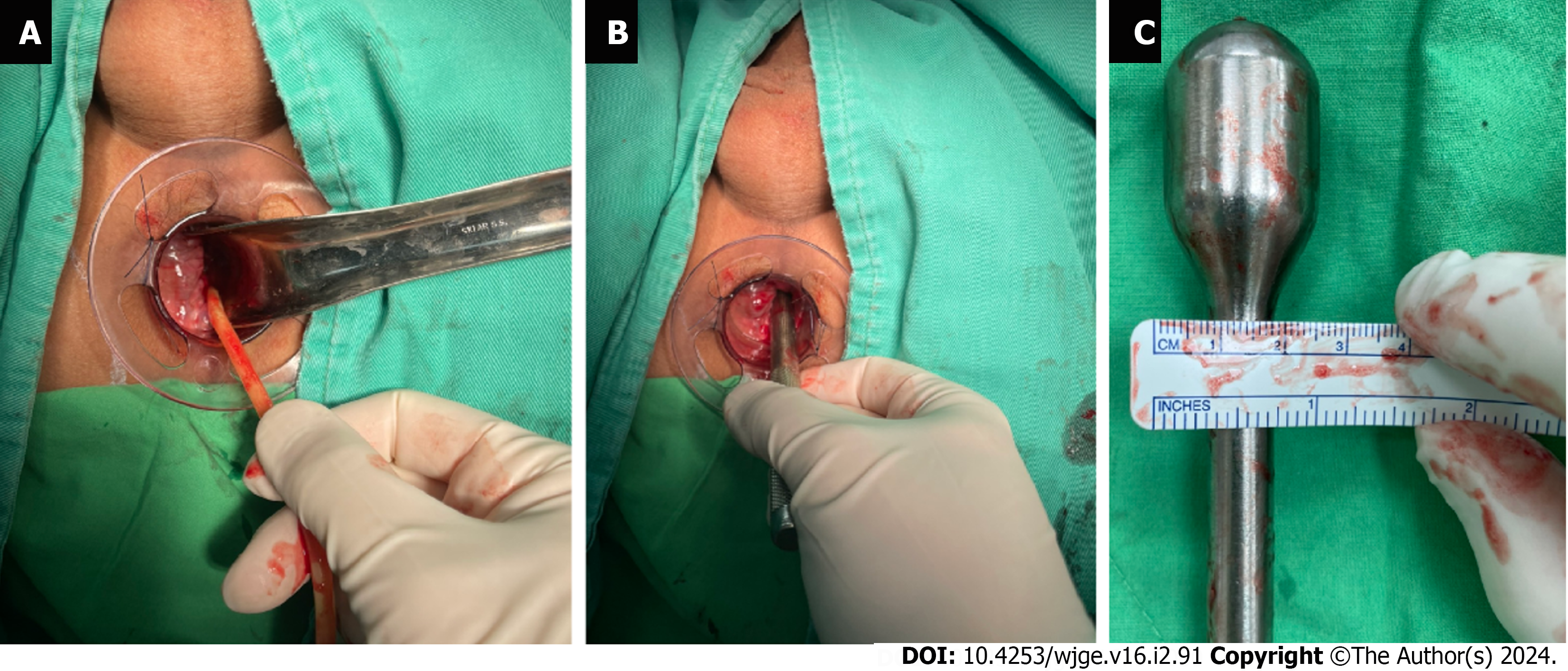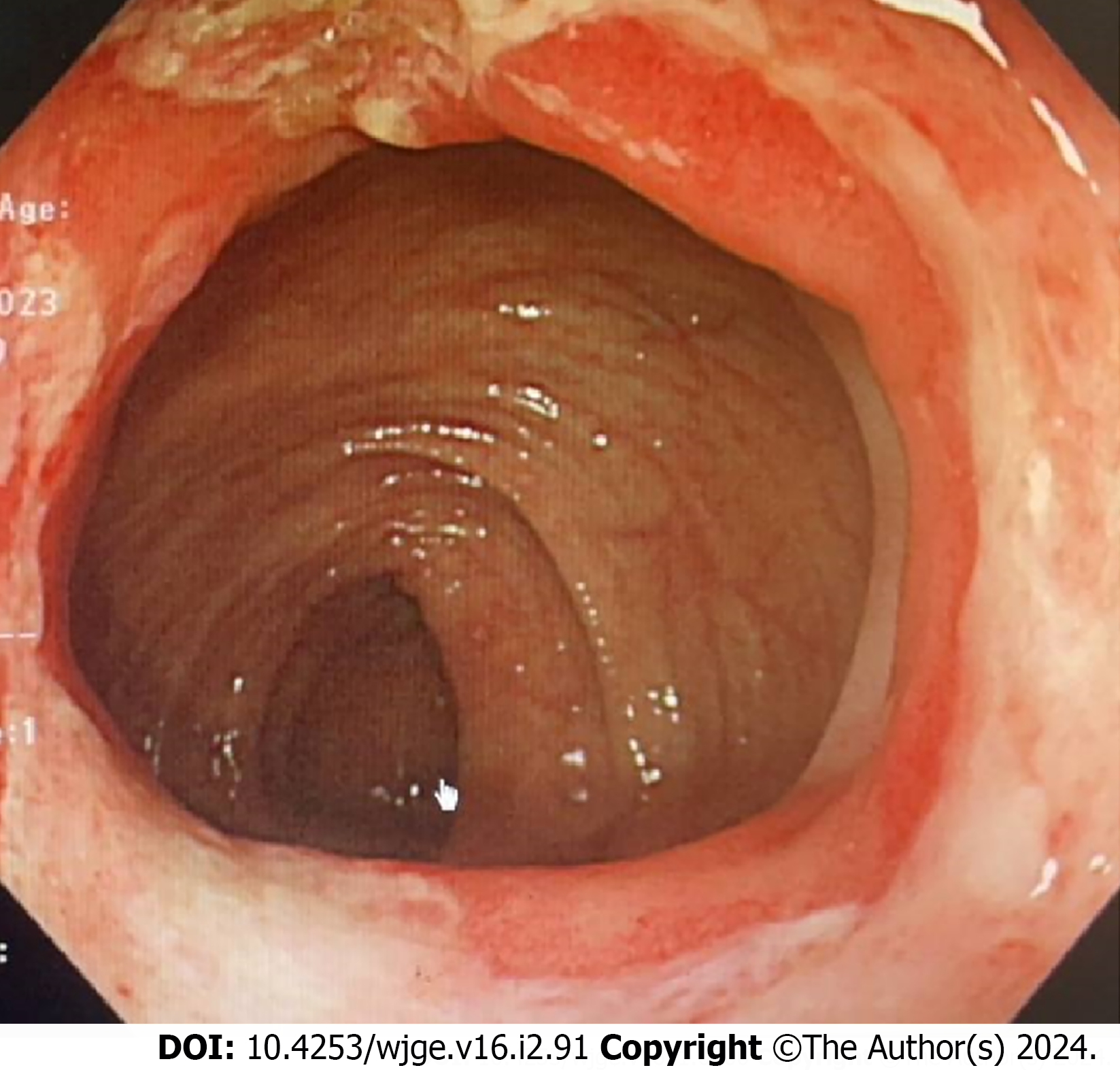Published online Feb 16, 2024. doi: 10.4253/wjge.v16.i2.91
Peer-review started: October 12, 2023
First decision: December 8, 2023
Revised: December 28, 2023
Accepted: January 22, 2024
Article in press: January 22, 2024
Published online: February 16, 2024
Processing time: 111 Days and 2.8 Hours
Benign rectal strictures can be categorized as primary (disease-related) and secondary (surgical anastomosis-related). Secondary strictures arise from surgical complications, whereas primary strictures have diverse etiologies, including various inflammatory conditions. Benign strictures are usually managed by surgery and endoscopy. We present an unusual etiology of benign rectal stricture caused by the repeated insertion of foreign objects into the rectum for sexual purposes, resulting in rectal injury and subsequent chronic inflammation.
A 53-year-old man presented to the outpatient clinic of the Colorectal Surgery Department with symptoms of chronic constipation and bloody stools. The patient previously experienced rectal injury due to foreign object insertion for sexual purposes. Colonoscopy revealed benign circumferential narrowing of the rectum. He underwent treatment by endoscopic argon plasma coagulation and balloon dilation and follow-up as an outpatient for 4 months. A colonoscopy at the end of the follow-up period revealed no evidence of rectal stricture relapse.
A history of rectal injury, followed by chronic inflammation, should be considered in patients with benign rectal strictures. Management with endoscopic argon plasma coagulation and balloon dilation can prevent the need for surgical resection of benign rectal strictures.
Core Tip: The etiologies of benign rectal stricture are primarily associated with chronic inflammation and post-surgical complications. We describe an unusual etiology caused by repeated insertion of foreign objects into the rectum for sexual purposes, resulting in rectal injury and subsequent chronic inflammation. Initiating treatment with endoscopic management and then considering surgical resection, if unsuccessful, might be the most suitable therapeutic strategy. Endoscopic argon plasma coagulation combined with balloon dilation is beneficial for treating benign rectal stricture.
- Citation: Liu SH, Kang JC, Hu JM, Chen CY, Lin KH, Pu TW. Treatment of benign rectal stricture caused by repeated anal insertion by endoscopy and balloon dilation: A case report. World J Gastrointest Endosc 2024; 16(2): 91-97
- URL: https://www.wjgnet.com/1948-5190/full/v16/i2/91.htm
- DOI: https://dx.doi.org/10.4253/wjge.v16.i2.91
Benign strictures of the rectum are classified as primary (disease-related) and secondary (surgical anastomosis-related)[1]. Secondary strictures arise from anastomotic dehiscence or ischemia, stapling devices, postoperative pelvic infections, or postoperative radiation-induced proctitis[2]. Etiological factors of primary strictures include nonsteroidal anti-inflammatory drug use[3], chronic proctitis (prevalent in inflammatory bowel disease)[4], tuberculosis[5], and complicated diverticulitis[6]. These factors primarily affect patients who have undergone recent surgery or have underlying inflammatory diseases. Proctitis is an inflammatory condition that affects the anal canal and/or rectum. It can result from inflammatory bowel disease, infectious proctitis due to sexually transmitted infections through genital-anal mucosal contact, or traumatic proctitis caused by digital contact or the use of foreign objects[7]. Benign strictures are usually managed surgically and endoscopically. However, an optimal approach to treating benign rectal strictures has not been established. We posit that initial endoscopy rather than surgical resection can improve patient satisfaction with more favorable postoperative outcomes. Here we describe a case of a homosexual male with an unusual rectal stricture. Although he denied receptive anal intercourse with men, he inserted toys or household items into the rectum via the anal canal for sexual eroticism. The rectum was damaged, chronically inflamed, and constricted. We applied a novel therapeutic approach comprising argon plasma coagulation (APC) and balloon dilation.
A 53-year-old Chinese man presented to the outpatient department of Tri-Service General Hospital, Songsang Branch with bloody stools.
The patient reported experiencing discomfort and difficulty passing stools for approximately 6 months that were not relieved by laxatives. He recalled having persistent anal pain and bleeding for approximately 2 wk after inserting anal toys and household items approximately 1 year before presentation; however, he did not seek medical assistance at that time.
The patient had no history of chronic diseases or surgeries.
The personal and family history of the patient was unremarkable.
Abdominal and digital rectal findings were not specific.
Laboratory serum examinations revealed no significant abnormalities.
Colonoscopy revealed an apparently benign, circumferential rectal stricture 6 cm above the anal verge (Figure 1) through which the colonoscope could not pass. A biopsy of the stricture revealed adenomatous hyperplasia with fibroblast proliferation.
Colonoscopy indicated a benign rectal stricture.
A colonoscopy with APC for tissue ablation at the stricture edge was performed after the initial diagnosis was confirmed (Figure 2). One week later, balloon dilation using a Foley catheter was performed. The balloon was inflated with 15 mL of water, and the diameter of the inflated balloon was approximately 25 mm. The stenosis improved, as evidenced by the smooth passage of a 25-mm anal dilator (Figure 3). Improvement in the patient’s symptoms was limited after 6 wk of follow-up. Therefore, the patient underwent a repeat colonoscopy with APC that achieved complete resolution of luminal narrowing (Figure 4).
No complications developed during the management. Four months after treatment, a repeat colonoscopy revealed no evidence of rectal stricture relapse (Figure 5). The patient's symptoms were completely resolved thereafter.
Rectal strictures typically form in an area of muscle that contracts over time and narrows or blocks the intestinal passage. These strictures have various underlying causes and are broadly categorized as benign or malignant. Benign rectal strictures often manifest as the outcome of an inflammatory cascade, leading to the development of hyperplastic scars and tissue fibrosis[8]. They can greatly affect the quality of life of patients, which leads to changes in bowel habits. They sometimes manifest as medical emergencies when they obstruct the bowel.
Anastomotic strictures associated with colorectal surgery were ruled out because the patient had not undergone any procedures. He had no history of drug use. Inflammatory bowel disease was unlikely as the patient did not have diarrhea. Endoscopic findings revealed no erosions, ulcers, edema, mucosal granularity, and friability[9]. Although rectal strictures are rarely associated with foreign bodies, one case report has described a rectal stricture caused by a chicken bone that had been retained for two years[10]. Rectal stricture can result from chronic inflammation caused by foreign body insertion. We inferred that repeated insertion of a foreign body over the long term caused the rectal injury in this patient. Rectal strictures can also occur due to burn injuries associated with hot water or coffee enemas[11,12]. All these causes similarly indicate that rectal injury can lead to strictures because of chronic inflammation. To the best of our knowledge, similar reports of rectal stricture caused by repeated foreign object insertion have not been published in the literature.
Various therapeutic approaches include the mechanical dilation of rectal strictures, electrocautery, manual widening, transanal mechanical stapling devices, endoscopic, and surgical methods[13]. Surgical procedures, such as resection and stricturoplasty, are more efficient than endoscopic approaches in addressing colorectal strictures. However, surgical resection and stricturoplasty are linked to a notably higher incidence of postoperative complications, which can require further diverting stoma and a greater likelihood of stricture recurrence[14,15]. Endoscopic methods such as implanted stents, electrocautery incision, balloon dilation, or combined management, are minimally invasive, simple procedures that can delay the need for surgery by an average of 6.5 years[16].
We avoided surgical resection for our patient because incontinence, frequency, and urgency, which are collectively described as low anterior resection syndrome would have adversely affected his quality of life[17]. The resolution of one issue would lead to the development of another. Stent placement was not selected because this can lead to complications over the long term such as stent dislodgment and obstruction due to fecal impaction[18]. We applied radial incisions using endoscopic electrocautery with APC to ensure that hyperplastic tissues were thoroughly cleaned within the incisions. An APC technique for benign colorectal strictures has been established[19]. The success rate of balloon dilation to treat surgical anastomotic and inflammatory disease-related strictures is approximately 97% and the incidence (< 3%) of major complications is low[20]. We used a Foley balloon instead of an endoscopic balloon because of the short length of the stricture. The Foley balloon could adequately cover the narrow area, which was close to the anus. Although recommendations for managing benign colorectal strictures have not been officially established, the outcome of treating our patient with APC combined with balloon dilation was successful. Nonetheless, long-term and regular colonoscopic surveillance is critically important to assess recurrence in patients with rectal strictures.
Benign rectal strictures are primarily associated with chronic inflammation and postoperative complications. Our patient had an unusual etiology that developed from the prolonged insertion of foreign objects into the rectum for pleasure, resulting in rectal injury and subsequent chronic inflammation. A standardized approach to treating this type of benign rectal stricture has not been established. However, initiating treatment with endoscopy and considering surgery if unsuccessful might be the most suitable strategy under such circumstances. We treated the rectal stricture using endoscopic APC in combination with balloon dilation, which avoided surgical resection of the rectum.
Provenance and peer review: Unsolicited article; Externally peer reviewed.
Peer-review model: Single blind
Specialty type: Gastroenterology and hepatology
Country/Territory of origin: Taiwan
Peer-review report’s scientific quality classification
Grade A (Excellent): 0
Grade B (Very good): 0
Grade C (Good): C
Grade D (Fair): 0
Grade E (Poor): 0
P-Reviewer: Gweon TG, South Korea S-Editor: Liu JH L-Editor: A P-Editor: Cai YX
| 1. | Chen M, Shen B. Comparable short- and long-term outcomes of colonoscopic balloon dilation of Crohn's Disease and benign non-Crohn's Disease strictures. Inflamm Bowel Dis. 2014;20:1739-1746. [RCA] [PubMed] [DOI] [Full Text] [Cited by in Crossref: 28] [Cited by in RCA: 29] [Article Influence: 2.6] [Reference Citation Analysis (0)] |
| 2. | Luchtefeld MA, Milsom JW, Senagore A, Surrell JA, Mazier WP. Colorectal anastomotic stenosis. Results of a survey of the ASCRS membership. Dis Colon Rectum. 1989;32:733-736. [RCA] [PubMed] [DOI] [Full Text] [Cited by in Crossref: 134] [Cited by in RCA: 131] [Article Influence: 3.6] [Reference Citation Analysis (0)] |
| 3. | Eis MJ, Watkins BM, Philip A, Welling RE. Nonsteroidal-induced benign strictures of the colon: a case report and review of the literature. Am J Gastroenterol. 1998;93:120-121. [RCA] [PubMed] [DOI] [Full Text] [Cited by in Crossref: 20] [Cited by in RCA: 17] [Article Influence: 0.6] [Reference Citation Analysis (0)] |
| 4. | Wibmer AG, Kroesen AJ, Gröne J, Buhr HJ, Ritz JP. Comparison of strictureplasty and endoscopic balloon dilatation for stricturing Crohn's disease--review of the literature. Int J Colorectal Dis. 2010;25:1149-1157. [RCA] [PubMed] [DOI] [Full Text] [Cited by in Crossref: 71] [Cited by in RCA: 64] [Article Influence: 4.3] [Reference Citation Analysis (0)] |
| 5. | Misra SP, Misra V, Dwivedi M, Arora JS, Kunwar BK. Tuberculous colonic strictures: impact of dilation on diagnosis. Endoscopy. 2004;36:1099-1103. [RCA] [PubMed] [DOI] [Full Text] [Cited by in Crossref: 15] [Cited by in RCA: 17] [Article Influence: 0.8] [Reference Citation Analysis (0)] |
| 6. | Cain BT, Huang LC. Benign Colonic Strictures. Dis Colon Rectum. 2021;64:1041-1044. [RCA] [PubMed] [DOI] [Full Text] [Cited by in Crossref: 2] [Cited by in RCA: 3] [Article Influence: 0.8] [Reference Citation Analysis (0)] |
| 7. | de Vries HJC, Nori AV, Kiellberg Larsen H, Kreuter A, Padovese V, Pallawela S, Vall-Mayans M, Ross J. 2021 European Guideline on the management of proctitis, proctocolitis and enteritis caused by sexually transmissible pathogens. J Eur Acad Dermatol Venereol. 2021;35:1434-1443. [RCA] [PubMed] [DOI] [Full Text] [Cited by in Crossref: 12] [Cited by in RCA: 47] [Article Influence: 11.8] [Reference Citation Analysis (0)] |
| 8. | Davis B, Rivadeneira DE. Complications of colorectal anastomoses: leaks, strictures, and bleeding. Surg Clin North Am. 2013;93:61-87. [RCA] [PubMed] [DOI] [Full Text] [Cited by in Crossref: 75] [Cited by in RCA: 83] [Article Influence: 6.4] [Reference Citation Analysis (0)] |
| 9. | Spiceland CM, Lodhia N. Endoscopy in inflammatory bowel disease: Role in diagnosis, management, and treatment. World J Gastroenterol. 2018;24:4014-4020. [RCA] [PubMed] [DOI] [Full Text] [Full Text (PDF)] [Cited by in CrossRef: 46] [Cited by in RCA: 91] [Article Influence: 13.0] [Reference Citation Analysis (0)] |
| 10. | Elmoghrabi A, Mohamed M, Wong K, McCann M. Proctalgia and colorectal stricture as the result of a 2-year transit of a retained rectal chicken bone: a case presentation and review of the literature. BMJ Case Rep. 2016;2016. [RCA] [PubMed] [DOI] [Full Text] [Cited by in Crossref: 2] [Cited by in RCA: 4] [Article Influence: 0.4] [Reference Citation Analysis (0)] |
| 11. | Kim S, Cha JM, Lee CH, Shin HP, Park JJ, Joo KR, Lee JI, Jeun JW, Lim K, Lim JU, Choi JH. Rectal perforation due to benign stricture caused by rectal burns associated with hot coffee enemas. Endoscopy. 2012;44 Suppl 2 UCTN:E32-E33. [RCA] [PubMed] [DOI] [Full Text] [Cited by in Crossref: 5] [Cited by in RCA: 5] [Article Influence: 0.4] [Reference Citation Analysis (0)] |
| 12. | Kye BH, Kim HJ, Lee KM, Cho HM. Intractable rectal stricture caused by hot water enema. J Korean Surg Soc. 2011;81:350-354. [RCA] [PubMed] [DOI] [Full Text] [Full Text (PDF)] [Cited by in Crossref: 3] [Cited by in RCA: 4] [Article Influence: 0.3] [Reference Citation Analysis (0)] |
| 13. | Garcea G, Sutton CD, Lloyd TD, Jameson J, Scott A, Kelly MJ. Management of benign rectal strictures: a review of present therapeutic procedures. Dis Colon Rectum. 2003;46:1451-1460. [RCA] [PubMed] [DOI] [Full Text] [Cited by in Crossref: 65] [Cited by in RCA: 67] [Article Influence: 3.0] [Reference Citation Analysis (0)] |
| 14. | Schlegel RD, Dehni N, Parc R, Caplin S, Tiret E. Results of reoperations in colorectal anastomotic strictures. Dis Colon Rectum. 2001;44:1464-1468. [RCA] [PubMed] [DOI] [Full Text] [Cited by in Crossref: 130] [Cited by in RCA: 124] [Article Influence: 5.2] [Reference Citation Analysis (0)] |
| 15. | Wolters FL, Russel MG, Stockbrügger RW. Systematic review: has disease outcome in Crohn's disease changed during the last four decades? Aliment Pharmacol Ther. 2004;20:483-496. [RCA] [PubMed] [DOI] [Full Text] [Cited by in Crossref: 83] [Cited by in RCA: 77] [Article Influence: 3.7] [Reference Citation Analysis (0)] |
| 16. | Shen B. Interventional IBD: The Role of Endoscopist in the Multidisciplinary Team Management of IBD. Inflamm Bowel Dis. 2018;24:298-309. [RCA] [PubMed] [DOI] [Full Text] [Cited by in Crossref: 18] [Cited by in RCA: 30] [Article Influence: 4.3] [Reference Citation Analysis (0)] |
| 17. | Dulskas A, Smolskas E, Kildusiene I, Samalavicius NE. Treatment possibilities for low anterior resection syndrome: a review of the literature. Int J Colorectal Dis. 2018;33:251-260. [RCA] [PubMed] [DOI] [Full Text] [Cited by in Crossref: 61] [Cited by in RCA: 82] [Article Influence: 11.7] [Reference Citation Analysis (0)] |
| 18. | Lamazza A, Fiori E, Sterpetti AV, Schillaci A, Scoglio D, Lezoche E. Self-expandable metal stents in the treatment of benign anastomotic stricture after rectal resection for cancer. Colorectal Dis. 2014;16:O150-O153. [RCA] [PubMed] [DOI] [Full Text] [Cited by in Crossref: 42] [Cited by in RCA: 31] [Article Influence: 2.8] [Reference Citation Analysis (0)] |
| 19. | Emhmed Ali S, Bhakta A, Bautista RM, Sherif A, Frandah W. Endoscopic stricturotomy with pulsed argon plasma and balloon dilation for refractory benign colorectal strictures: a case series. Transl Gastroenterol Hepatol. 2022;7:32. [RCA] [PubMed] [DOI] [Full Text] [Cited by in RCA: 2] [Reference Citation Analysis (0)] |
| 20. | Ambrosetti P, Francis K, De Peyer R, Frossard JL. Colorectal anastomotic stenosis after elective laparoscopic sigmoidectomy for diverticular disease: a prospective evaluation of 68 patients. Dis Colon Rectum. 2008;51:1345-1349. [RCA] [PubMed] [DOI] [Full Text] [Cited by in Crossref: 56] [Cited by in RCA: 52] [Article Influence: 3.1] [Reference Citation Analysis (0)] |

















